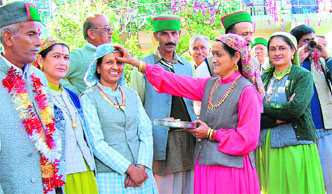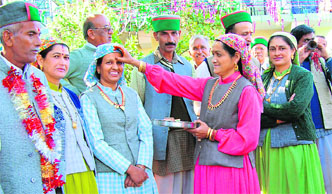
Rahide
Rahide is a long head scarf worn by the women of Himachal Pradesh to protect their heads from cool breeze and also to depict their tradition.
Woven in all shapes and sizes, Rahide comes in different fabrics and patterns. The most commonly used pattern is the floral print that denotes the rich flora and fauna of the state and its surroundings. The preferred fabric to make a head scarf is wool due to cold climatic conditions though cotton is as popular. Red colored scarves with golden fringes are prominent.
History
These scarves have been made mostly by the local women from centuries now. The pahari culture is replete with beautiful pieces like coverlets, hand fans, scarves, caps, prayer gloves (gaumukhi).
Variety
The double-sided silk ‘rumals’ or scarves of Chamba are a burst of color and look very stylish when worn as stoles too. The designs embroidered on them illustrate scenes of Mahabharata, Ramayana and other great epics. Even if you do not have a good stock of woolen clothes with yourself while traveling here, you can always buy warm shawls, hand-knit socks and sweaters from Himachal Pradesh.
Shawls are popular, the pashmina (made from pashmina goats) being the most prominent among them are exported globally.
Personalisation and Accessorizing
Scarves are being used as a fashion accessory both by women and men globally. The diverse and beautiful rustic patterns which have been simplified have made this traditional weave much in demand.
Women wear Salwar Kurtas or ghaghiri and embroidered cholis with the Rahide- the head scarf. The scarf is worn around the forehead and knotted at the head.
Present Day Scenario
The rich culture of Himachal Pradesh is reflected in the apparel, which has charmed people the world over much like its creators, the local women. Jamavar woolen scarves, woven by the artisans are gorgeous, comfortable, resilient and made from natural wool are infused with colours which number from two to fifty.
The Making
Each scarf takes few hours and sometimes two days to be design, depending on the intricacies desired. A single or dual tone is used with normal wool blended with fine mohair or Silk. The expertise of the local women who have been weaving this magical art for generations have stayed true to its traditional style but have also evolved the style with the changing fashion trends. Mixes of bright colors, fancier patterns, and trendier designs have become rampant in the mass production of these scarves.
Variety
Wool, cotton, silk, jacquard, georgette, viscose, polyester and chiffon are used to weave head scarves, which are draped in a multitude of ways. The designs range from mythological motifs, mangoes, floral patterns to beaded designs and much more.
The materials are sourced from Pashmina, angora, and yak along with sheep wool in different grades. The pricing varies from Rs.350/- to Rs.900/- onwards depending on the fabric and embellishments on it.
Maintenance
The silk and woollen scarves can be washed with a mild detergent and should not be soaked for a long time. It is advisable to get them dry cleaned after the initial use.
Interesting Facts and Comparisons
- The Rahide or head scarf is being reinvented to appeal to people the world over. The designs and fabrics are available in mind boggling patterns and colours.
- The scarf became a real fashion accessory by the early 19th Century for both men and women. By the middle of the 20th Century scarves became one of the most essential and versatile clothing accessories for both men and women.
- The Lavi fair is one of the oldest fairs of Himachal is held in the month of November in Rampur. This world-famous fair attracts many tourists because of the assortment of goods sold ranging from woolens to handicrafts, to spices.
- The picturesque location of Himachal Pradesh and the hospitable people who produce such beautiful crafts leave visitors with warm memories and beckon them to return time and again.
Reference
Categories: Attires, Clothing Styles & Drapes

